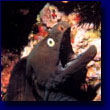![]()
| Ichthyoplankton ecology |
Field investigations of fish eggs and larvae (ichthyoplankton) originated in the late 1800s. The motivations for investigations have changed little over this period, being mainly the assessment of adult spawning biomass and distribution, and the desire to understand how environmental variations and changes in the abundance of other species interact to regulate the abundance in particular fish populations. The factors affecting recruitment, in particular those that affect the survival of fish eggs and larvae, are of key importance in this context.
plankton sample including sardine eggs and larvae
The process of recruitment, in spite of about 100 years of research, is still not fully understood. Trophic relations are implicated as a major influence on early fish life dynamics and are embodied in the "critical period" (Hjort) and "match-mismatch" (Cushing) hypothesis. Spatial characteristics are also considered of importance in the alternative "member-vagrant" (Sinclair) hypotheses.
The usual objectives of field studies of egg and larval fish can be grouped under three headings:
-
(i) direct assessment of the numbers or biomass in exploitable populations;
(ii) determination of the underlying processes affecting survival and so recruitment of the parent population;
(iii) development of understanding of ecosystem and marine population dynamics.
Between spawning and recruitment into the adult population, most fishes undergo changes in morphology and habits.
The most general scheme of terminology of early development of fishes includes:
-
(i) the "egg stage" fish eggs
(spawning to hatching);
(ii) the "larval stage" sardine larva (hatching to attainment of complete fin ray counts and beginning of squamation). One of the fundamental events in the development of most fishes is the flexion of the notochord that accompanies the hypochondral development of the homocercal caudal fin. It is convenient to divide the larval stage on the basis of this feature into "preflexion", "flexion", and "postflexion" stages;
(iii) the "juvenile stage" (completion of fin ray counts and beginning of squamation until fish enters adult population or attains sexual maturity).
